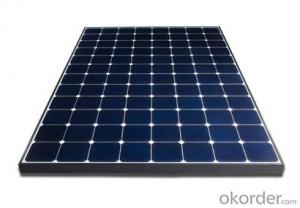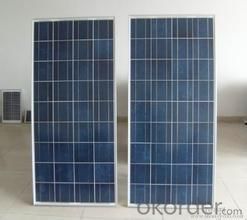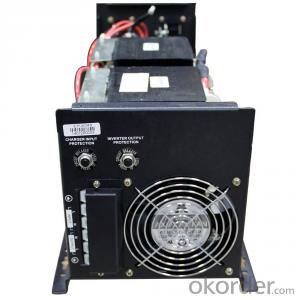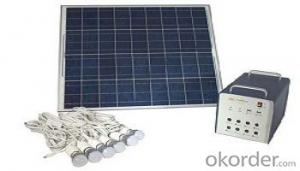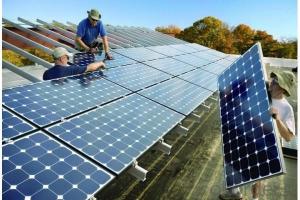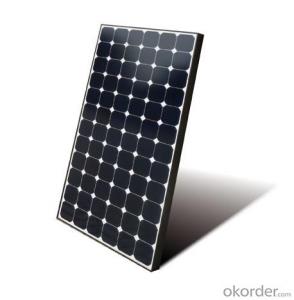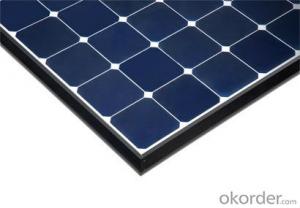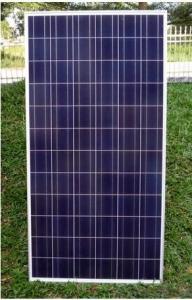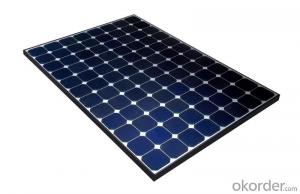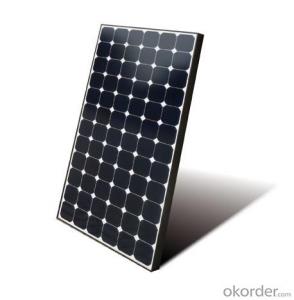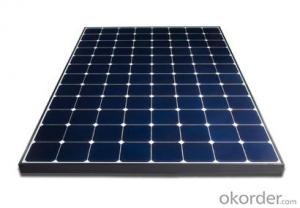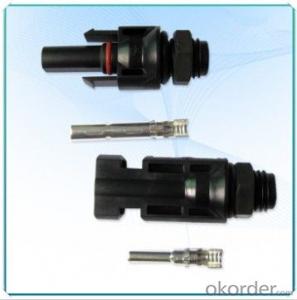Affordable Solar Energy Systems:CNBM On-Grid System 10kW with Certificate UL, TUV, CE
- Loading Port:
- Shanghai
- Payment Terms:
- TT OR LC
- Min Order Qty:
- 100 watt
- Supply Capability:
- 1000 watt/month
OKorder Service Pledge
OKorder Financial Service
You Might Also Like
Specification
CNBM On Grid System 10KW with Certificate UL TUV CE
Product description
They range from small residential and commercial rooftop systems to large utility-scale solar power stations. Unlike stand-alone power systems, a grid-connected system rarely includes an integrated battery solution, as they are still very expensive. When conditions are right, the grid-connected PV system supplies the excess power, beyond consumption by the connected load, to the utility grid.
Connection of the photovoltaic power system can be done only through an interconnection agreement between the consumer and the utility company. The agreement details the various safety standards to be followed during the connection.[4]
Bypass diodes may be incorporated or used externally, in case of partial module shading, to maximize the output of module sections still illuminated.Systems such as Net Metering and Feed-in Tariff which are offered by some system operators, can offset a customers electricity usage costs. In some locations though, grid technologies cannot cope with distributed generation feeding into the grid, so the export of surplus electricity is not possible and that surplus is earthed.
Grid-connected PV systems are comparatively easier to install as they do not require a battery system.[1][6]
Grid interconnection of photovoltaic (PV) power generation systems has the advantage of effective utilization of generated power because there are no storage losses involved.[7]
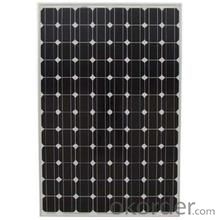
Application
Industrial
Commercial
Residential
Feature
Residential, grid-connected rooftop systems which have a capacity more than 10 kilowatts can meet the load of most consumers.[2] They can feed excess power to the grid where it is consumed by other users. The feedback is done through a meter to monitor power transferred. Photovoltaic wattage may be less than average consumption, in which case the consumer will continue to purchase grid energy, but a lesser amount than previously. If photovoltaic wattage substantially exceeds average consumption, the energy produced by the panels will be much in excess of the demand. In this case, the excess power can yield revenue by selling it to the grid. Depending on their agreement with their local grid energy company, the consumer only needs to pay the cost of electricity consumed less the value of electricity generated. This will be a negative number if more electricity is generated than consumed.[3] Additionally, in some cases, cash incentives are paid from the grid operator to the consumer.
Packaging
With carton and box
- Q: Can solar energy systems be used for powering research laboratories or scientific facilities?
- Solar energy systems are indeed capable of powering research laboratories or scientific facilities. The scientific community is increasingly embracing solar energy due to its numerous advantages. To begin with, solar energy systems are highly dependable and require minimal upkeep. Once installed, they can consistently and continuously supply power to research laboratories or scientific facilities, ensuring uninterrupted operations. This is particularly crucial for facilities that rely on continuous power, such as those conducting experiments or operating sensitive equipment. Moreover, solar energy is a clean and renewable power source. By utilizing solar energy systems, research laboratories and scientific facilities can significantly reduce their carbon footprint and contribute to the global fight against climate change. This aligns with the scientific community's commitment to sustainability and environmental responsibility. In addition, solar energy systems can help lower energy costs for research laboratories and scientific facilities. Although the initial investment in installing solar panels may be higher, the long-term savings on electricity bills can be substantial. This frees up resources that can be allocated to other important research activities or equipment upgrades. It is also worth noting that advancements in solar technology have enhanced its efficiency, enabling it to generate power even in areas with less sunlight. This means that research laboratories and scientific facilities located in regions with varying weather conditions can still benefit from solar energy systems. In conclusion, solar energy systems offer a viable and advantageous solution for powering research laboratories or scientific facilities. They provide reliable, clean, and cost-effective energy, aligning with the sustainability goals of the scientific community. As solar technology continues to improve, the use of solar energy in research facilities is expected to become even more widespread.
- Q: What is the role of solar-powered water heaters in solar energy systems?
- Solar-powered water heaters play a crucial role in solar energy systems by utilizing the sun's energy to heat water for various purposes such as domestic use, heating, and even industrial processes. By harnessing solar power, these devices reduce the reliance on traditional energy sources, thus promoting sustainability and environmental conservation. Additionally, solar water heaters contribute to energy efficiency and cost savings by reducing the need for electricity or gas to heat water, making them an important component of solar energy systems.
- Q: Can solar energy systems be used in areas with limited access to solar energy advocacy groups?
- Yes, solar energy systems can still be used in areas with limited access to solar energy advocacy groups. While advocacy groups can play a crucial role in promoting and supporting the adoption of solar energy, the installation and use of solar energy systems primarily depend on the availability of sunlight. As long as there is sufficient sunlight in an area, solar energy systems can be installed and utilized without the direct involvement of advocacy groups. In such cases, individuals or organizations can seek professional assistance from solar energy service providers, technicians, or manufacturers to install and maintain solar energy systems.
- Q: Can solar energy systems be used in powering shopping malls or retail centers?
- Yes, solar energy systems can definitely be used to power shopping malls or retail centers. These large commercial spaces typically have large roof areas that can accommodate a significant number of solar panels. By installing solar energy systems, these establishments can reduce their reliance on grid electricity and lower their operational costs. Additionally, solar energy systems can help reduce carbon emissions and promote sustainability in the retail industry.
- Q: How does solar energy impact job creation?
- Solar energy impacts job creation by creating a significant number of new employment opportunities. The growing demand for solar installations and maintenance has led to the creation of jobs in manufacturing, installation, sales, and research and development sectors. Additionally, the renewable nature of solar energy ensures long-term job stability, contributing to a sustainable and green economy.
- Q: Can solar energy systems be used in powering wastewater treatment plants?
- Solar energy systems have the capability to power wastewater treatment plants. This clean and renewable source of electricity can be harnessed through the utilization of solar panels, which capture sunlight and convert it into usable power for the various processes within a wastewater treatment facility. There are several advantages to employing solar energy systems in the operation of wastewater treatment plants. Firstly, solar power is abundant and accessible in most regions, making it a dependable energy source. This reduces reliance on fossil fuels and helps mitigate the environmental impact associated with conventional energy sources. Additionally, solar energy systems require minimal maintenance and have low operational costs compared to traditional power sources. Once the initial investment in solar panels is made, ongoing expenses are significantly reduced, resulting in long-term cost savings. Moreover, solar-powered wastewater treatment plants contribute to the reduction of greenhouse gas emissions. By transitioning to renewable energy, these facilities can greatly decrease their carbon footprint and aid in the fight against climate change. Furthermore, solar energy systems can be easily integrated into existing wastewater treatment plants, powering vital components such as pumps, motors, and aeration systems necessary for the treatment process. However, it is crucial to consider the specific energy requirements of each wastewater treatment plant when implementing solar energy systems. The size and capacity of the solar panels must be carefully determined to ensure consistent generation of sufficient electricity to meet the plant's needs. In conclusion, solar energy systems are indeed capable of powering wastewater treatment plants. They offer numerous benefits including cost savings, reduced environmental impact, and seamless integration. As the world continues to prioritize sustainable energy solutions, solar-powered wastewater treatment plants are gaining popularity and are a significant step towards a greener and more sustainable future.
- Q: Can solar energy systems be used in powering construction sites or temporary structures?
- Yes, solar energy systems can definitely be used to power construction sites or temporary structures. In fact, solar power is increasingly being utilized in these scenarios due to its numerous advantages. Firstly, construction sites often lack access to traditional power sources, which makes solar energy a practical solution. Solar panels can be easily installed on rooftops, scaffolding, or even on the ground, providing a reliable source of electricity throughout the construction process. Secondly, solar energy systems offer flexibility in terms of power generation. They can be customized to meet specific energy demands of construction sites, whether it is for running power tools, lighting, or charging equipment. This adaptability ensures that construction activities can proceed smoothly without interruptions. Additionally, solar energy systems are environmentally friendly. By harnessing energy from the sun, construction sites can significantly reduce their carbon footprint and contribute to sustainable practices. Solar power does not produce harmful emissions or noise pollution, which is particularly beneficial in urban areas or sensitive environments. Furthermore, solar energy systems offer cost savings in the long run. While the initial investment for installing solar panels might be higher compared to traditional generators, the ongoing operational costs are significantly lower. Construction sites can benefit from reduced fuel expenses, maintenance costs, and reliance on fossil fuels. It is worth mentioning that solar energy systems can also be used for temporary structures such as mobile offices, portable restrooms, or event venues. These structures can be easily powered using solar panels, eliminating the need for generators or grid connections. In conclusion, solar energy systems are a viable and sustainable option for powering construction sites and temporary structures. They provide reliable, customizable, and cost-effective power solutions while minimizing environmental impact. As the global shift towards renewable energy continues, solar power will likely become even more prevalent in construction industry practices.
- Q: How much space is needed for installing a solar energy system?
- The amount of space needed for installing a solar energy system depends on various factors such as the size and type of the system, the energy requirements, and the available sunlight. Generally, a small residential solar energy system can be installed on rooftops or in a backyard with an area of about 100-400 square feet, while larger systems for commercial or industrial use may require several acres of land. It is important to conduct a site assessment to determine the suitable space for installation based on individual needs and local conditions.
- Q: Can solar energy systems be used in areas with frequent hurricanes?
- Yes, solar energy systems can be used in areas with frequent hurricanes. However, it is important to design and install them in a way that takes into account the specific challenges posed by hurricanes, such as high winds and potential debris impact. Reinforced mounting systems, robust solar panels, and proper installation techniques can help ensure the durability and resilience of solar energy systems in hurricane-prone areas. Additionally, incorporating battery storage can provide energy backup during power outages caused by hurricanes.
- Q: Can solar energy systems be used for powering research laboratories?
- Certainly, research laboratories can be powered by solar energy systems. Solar energy offers a clean and renewable power source that can be harnessed using photovoltaic (PV) panels or solar thermal systems. To meet the electricity demands of research laboratories, which often require significant power for equipment, lighting, and ventilation, solar energy is an effective solution. One option is to install solar PV panels on the laboratory's rooftop or surrounding open areas. These panels capture sunlight and convert it into electricity, which can then be used to power the laboratory's infrastructure, including computers, microscopes, refrigeration units, and specialized equipment. Any excess electricity can be stored in batteries or fed back into the grid, providing energy for later use or offsetting costs. Alternatively, solar thermal systems can generate heat for laboratory processes that require heating, such as sterilization or chemical reactions. These systems use sunlight to heat a fluid, which can be utilized directly or indirectly to provide heat to the laboratory. By implementing solar energy systems, research laboratories not only reduce reliance on fossil fuels but also decrease greenhouse gas emissions, contributing to environmental sustainability. In the long run, it can lead to cost savings as solar energy is essentially free once the initial installation costs are recovered. It is important, however, to consider the specific energy requirements of the laboratory and conduct a comprehensive feasibility study before installing solar energy systems. Factors such as location, available sunlight, roof orientation, and space availability should be taken into account to ensure optimal system performance. Additionally, a backup power source or grid connection may be necessary to ensure uninterrupted power supply during periods of low sunlight or high energy demand. In conclusion, solar energy systems offer a sustainable and viable solution for powering research laboratories, providing clean and reliable energy to support scientific advancements.
Send your message to us
Affordable Solar Energy Systems:CNBM On-Grid System 10kW with Certificate UL, TUV, CE
- Loading Port:
- Shanghai
- Payment Terms:
- TT OR LC
- Min Order Qty:
- 100 watt
- Supply Capability:
- 1000 watt/month
OKorder Service Pledge
OKorder Financial Service
Similar products
Hot products
Hot Searches
Related keywords
